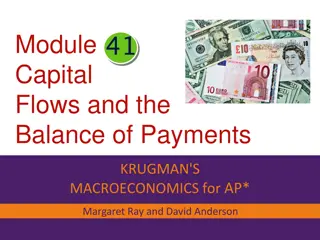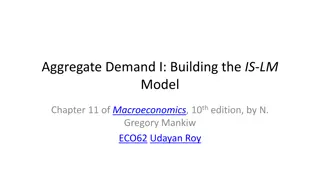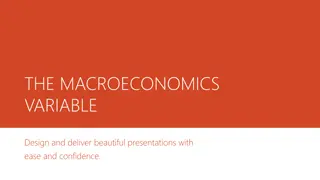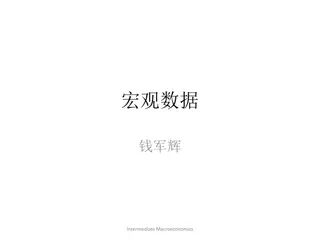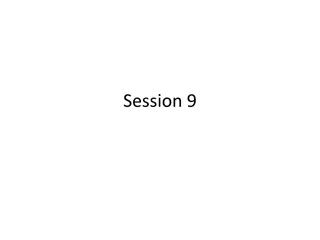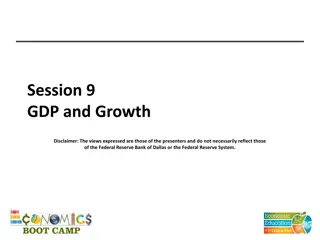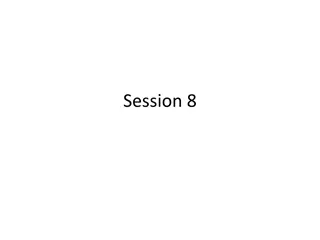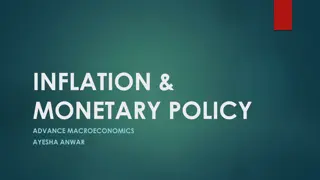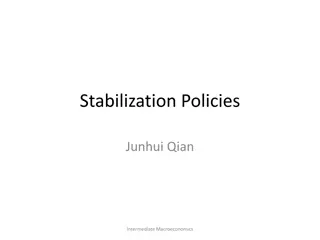Global Macroeconomics Insights
Dive into the intricacies of the global macroeconomics landscape with a focus on equilibrium in the aggregate demand-aggregate supply model. Explore the AS-AD model, short-run macroeconomic equilibrium, demand and supply shocks, and long-run macroeconomic equilibrium. Understand how economic fluctuations are analyzed and the significance of reaching equilibrium in different economic scenarios.
Download Presentation

Please find below an Image/Link to download the presentation.
The content on the website is provided AS IS for your information and personal use only. It may not be sold, licensed, or shared on other websites without obtaining consent from the author.If you encounter any issues during the download, it is possible that the publisher has removed the file from their server.
You are allowed to download the files provided on this website for personal or commercial use, subject to the condition that they are used lawfully. All files are the property of their respective owners.
The content on the website is provided AS IS for your information and personal use only. It may not be sold, licensed, or shared on other websites without obtaining consent from the author.
E N D
Presentation Transcript
ECO 120 - Global Macroeconomics TAGGERT J. BROOKS
Module 19 EQUILIBRIUM IN THE AGGREGATE DEMAND-AGGREGATE SUPPLY MODEL
3 of 17 The AS AD Model The AS-AD model uses the aggregate supply curve and the aggregate demand curve together to analyze economic fluctuations.
4 of 17 Short-Run Macroeconomic Equilibrium The economy is in short-run macroeconomic equilibrium when the quantity of aggregate output supplied is equal to the quantity demanded. The short-run equilibrium aggregate price level is the aggregate price level in the short-run macroeconomic equilibrium. Short-run equilibrium aggregate output is the quantity of aggregate output produced in the short- run macroeconomic equilibrium.
5 of 17 The AS AD Model Aggregate price level S R AS Short-run macroeconomic equilibrium PE ESR AD YE Real GDP
6 of 17 Demand Shocks (a) A Negative Demand Shock (b) A Positive Demand Shock Aggregate price level Aggregate price level A positive demand shock... A negative demand shock... S RAS S RAS P1 ...leads to a higher aggregate price level and higher aggregate output. P2 E E1 2 ...leads to a lower aggregate price level and lower aggregate output. P2 P1 E1 E 2 AD2 AD1 AD1 AD2 Y2 Y1 Y1 Y2 Real GDP Real GDP
7 of 17 Supply Shocks (a) A Negative Supply Shock (b) A Positive Supply Shock Aggregate price level Aggregate price level A positive supply shock... A negative supply shock... SRAS SRAS 2 SRAS1 1 SRAS2 E E 2 1 P2 P1 ...leads to a higher aggregate output and lower aggregate price level. leads to a lower aggregate output and a higher aggregate price level. E1 E2 P1 P2 AD AD Y1 Y2 Y2 Y1 Real GDP Real GDP
Long-Run Macroeconomic Equilibrium The economy is in long-run macroeconomic equilibrium when the point of short-run macroeconomic equilibrium is on the long-run aggregate supply curve.
Long-Run Macroeconomic Equilibrium L R AS S R AS Aggregate price level Long-run macroeconomic equilibrium PE ELR AD YP Real GDP Potential output
Short-Run Versus Long-Run Effects of a Negative Demand Shock 2. reduces the aggregate price level and aggregate output and leads to higher unemployment in the short run Aggregate price level L R AS S R AS1 SRAS 2 P E1 1 1. An initial negative demand shock 3. until an eventual fall in nominal wages in the long run increases short-run aggregate supply and moves the economy back to potential output. P 2 E 2 P3 E3 AD1 AD2 Y2 Y1 Potential output Real GDP Recessionary gap
Short-Run Versus Long-Run Effects of a Positive Demand Shock 1.An initial positive demand shock L R AS Aggregate price level S R AS1 E3 P3 P E2 2 E1 2. increases the aggregate price level and aggregate output and reduces unemployment in the short run P1 AD2 AD 1 Y1 Y2 Potential output Real GDP 11 of 17 Inflationary gap
Long-Run Macroeconomic Equilibrium There is a recessionary gap when aggregate output is below potential output. There is an inflationary gap when aggregate output is above potential output. The output gap is the percentage difference between actual aggregate output and potential output.
Long-Run Macroeconomic Equilibrium The economy is self-correcting when shocks to aggregate demand affect aggregate output in the short run, but not the long run.




